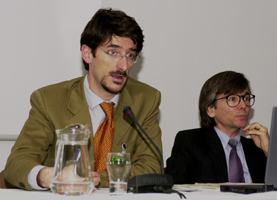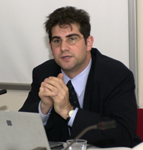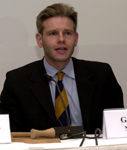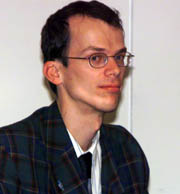|
| ||||
Monday 13 | Tuesday 14 | Wednesday 15 | Thursday 16 | Friday 17 | Saturday 18 | |
||||
|
|
||||
Ancillary benefits and costs of greenhouse gas mitigation
presented by the Organisation for Economic Co-operation and Development
(OECD)
Joke Waller-Hunter, Environment Director, OECD, noted that combustion fuels are the main source of greenhouse gases and that it is generally understood that policies to reduce GHGs can have positive and negative "ancillary effects" on public health, ecosystems, and land use. More information: |
||||
|
Carbon sequestration, biodiversity and sustainable livelihoods presented by the World Conservation Union (IUCN)
Brett Orlando, IUCN, emphasized the importance of the Kyoto Protocol and supported the creation of long-term institutional architecture for managing climate change. Bob Scholes, CSIR Environmentek, provided a technical view on carbon sinks and the implications for biodiversity. He stressed that LULUCF activities can have an impact on reducing carbon emissions as an interim contribution and as long as it is approached cautiously. On LULUCF activities, Arnold van Vliet, Wageningen University, said it is important to value the full range of services provided by forests. Tomme R. Young, IUCN Environmental Law Centre, spoke on "Forests, Law and the FCCC Implementation Mechanisms: the importance of rule-based methods." Providing an overview of the legal mechanisms for including LULUCF activities under the Kyoto Protocol, she stressed the critical importance of defining a forest and establishing baselines. Discussion: The issue of leakage was raised and concern was voiced over the ownership and management of carbon credits. It was suggested that a ton-year approach would help resolve these problems. An indigenous representative from Ecuador spoke about the importance of an integrated approach to forest preservation. More information: Contact : |
||||
|
Russian view on the future of the Kyoto Protocol presented by the Center for Preparation and Implementation of International Technical Assistance Projects (CPPI) On the negotiations, he underlined the importance of supplementarity and the prospect of reinvesting emissions trading revenues in domestic project activities. He advocated fungibility and across the three mechanisms and simplification of rules and procedures. He also supported early implementation of Joint Implementation (JI) and emissions trading. Alexander Kosarikov, Deputy Chairman of the Ecology Committee of the State Duma of the Russian Federation, described the effects of climate change on the Russian economy, focusing on the agricultural sector. He advocated the early implementation of JI projects and linked Russian ratification of the Protocol to the approval of domestic quotas for emissions trading. Oleg Pluzhnikov, Russian Ministry of Energy, noted that a new energy strategy would be approved after COP-6. Mikhail Rogankov, Russian United Energy System (RAO-UES), announced that the development of a company-wide GHG emissions inventory would be ready by the end of 2000 and noted the potential contribution of JI projects. Marina Martynova, Deputy Chair of the Board, Energy Carbon Fund (RAO-UES), explained that the fund is used to evaluate GHG emission reductions that have been achieved and to prepare JI and CDM project portfolios. Alexey Kokorin, WWF Russian Programme Office, speaking on behalf of Russian NGOs, noted concerns about a lack of transparency and public access to decision-making in the Russian Federation. Discussion: Participants discussed domestic quotas for emissions trading, energy saving programs, early JI and CDM activities, and the acceptance of adaptation fees subject to funding by the GEF. More Information: |
||||
|
presented by the University of California, Lawrence Berkeley National Laboratory (LBNL) Reports of research in progress from India, South Africa, China and Brazil were outlined at this event on multi-project baselines (MPBs). Chairing the event, Jayant A Sathaye, Berkeley National Laboratory, underlined the importance of establishing a "standardized procedure" for MPBs, given the time and expense involved in pursuing a project-by-project approach. He said that a multi-project approach can improve consistency, transparency and credibility. Harald Winkler, Energy and Development Research Centre, University of Cape Town, outlined potential standardized baselines for the power generation sector in South Africa, using near future plants to define a reference scenario. He noted the trade-off between environmental integrity and minimizing transaction costs, when setting benchmarks. Prof. Joyashree Roy, Jadavpur University, Calcutta, outlined research on calculating a MPB for the Eastern Regional Grid in India. She reported on a number of approaches to baseline construction, including aggregate sectoral trends, average of generation by fuel type, an approach specific to generation companies or project-specific, and outlined results of four benchmark scenarios. Roberto Schaeffer, Federal University of Rio de Janeiro, outlined research on the impact of MPBs on CDM projects in the Brazilian cement industry. He outlined a list of CDM-candidate projects. The findings suggest that fossil-fuel projects do not perform well using a sector-wide analysis. Oil-and coal-fueled plants only perform well compared to fuel-specific plants. Prof. Yanjia Wang, US/China Energy and Environment Technology Centre, Beijing, outlined research findings which suggest that China's cement sector should adopt international advanced technologies to ensure additionality to meet the requirements of the CDM. Discussion: Participants raised questions on the CDM's core role in supporting sustainable development, the desirability of reviewing baselines over the lifetime of a project, to take into account changes in the fuel mix, designing technology hurdles to deal with "free riders", and the impact of energy "pilfering" on accounting in the electricity sector. Contact: Jayant A Sathaye <jasathaye@lbl.gov> |
||||
|
LULUCF activities under the Clean Development Mechanism: Opportunity or threat to biological diversity conservation? presented by Intercooperation Speaking in an individual capacity, Pedroni described in detail a list of 24 criteria for including forests under the CDM and offered insights into the synergies between the Convention on Biological Diversity (CBD) and the FCCC. His recommendations included suggestions for a peer review panel to be appointed by the Executive Board of the CDM and for NGOs, private entities and Parties to have legal recourse to challenge decisions on the registration of a particular project activity or the issue of CERs. He concluded that linkages between the CBD and FCCC deserve further investigation. Discussion: Participants welcomed the list of criteria and cited the experience of the Forest Stewardship Council (FSC). Certification was discussed at length followed closely by the controversy over the definition of forests. It was suggested that an important starting point for considering sinks under the Protocol would be to establish a clearly defined distinction between large-scale industrial plantations, small-scale agroforestry plantations and natural forests in the tropics. It was proposed that the inclusion of sinks under the CDM might be more acceptable to some NGOs and indigenous peoples if these definitions were developed and presented to the COP-6 Parties. Several participants highlighted the need for an appropriate institutional framework. Contact: |
||||
|
Emissions trading: from the virtual to the real? An update on GETS2
presented by EURELECTRIC Giuseppe Montesano, Enel, modeled a virtual utility with a portfolio of generation assets ranging from conventional oil/gas steam plants to efficient gas-fired combined cycle units. Their first strategy was to replace those plants with new combined cycles, which reduced the virtual utility's emissions by approximately 25%. He suggested that in the absence of a market, meeting Kyoto Protocol targets would have been much more expensive and would have resulted in higher electricity prices. Helmut Groscurth, Hamburgische Electricitäts-Werke (HEW), noted that policy makers are developing policy instruments for tighter environmental regulations, including those for the KP, that are not in line with the current liberalization of the European electricity market. HEW anticipate many business opportunities in the emerging "green" markets, such as green electricity and renewable energy credits. Garth Edward, Natsource, presented a broker's point of view. He noted that market makers were restricted in this exercise, and explained that his goal was to create more depth and liquidity in the virtual market. J-P Bourdier, EURELECTRIC, concluded that GETS2 has shown that a carbon trading market is feasible and that governments now have to decide on its modalities. Discussion: Discussions focused on: how governments, the European Union and European Commission, view such markets; the risks associated with different trading instruments; and how market rules would be enforced within a homogenous European market and enforced between continents. More information: |
||||
| |
Defining investment additionality for CDM projects - practical approaches
presented by the German Delegation in collaboration with GTZ
More Information: |
| © 2000, IISD. All rights reserved. |
|









